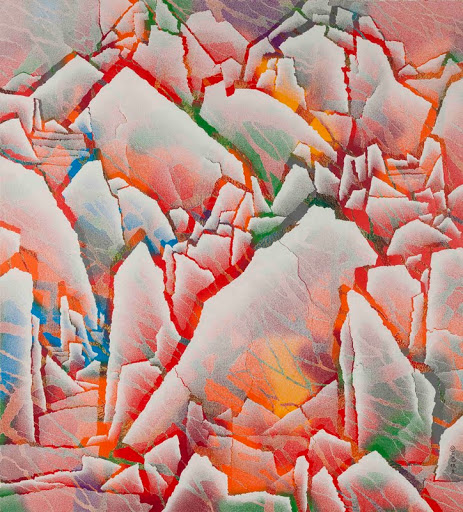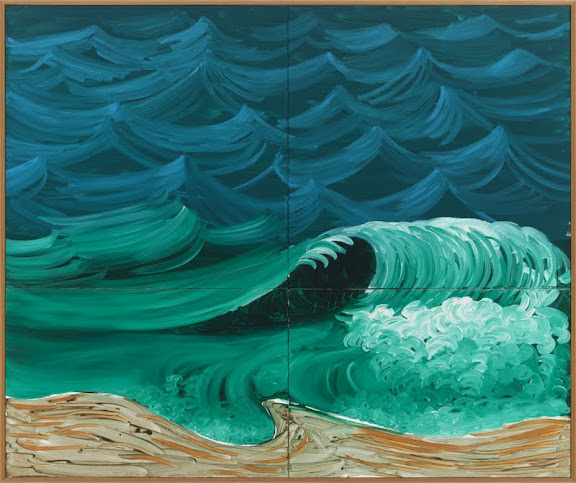
EXPO CHICAGO 2015, the International Exposition of Contemporary & Modern Art, is due to take place from the 17th to the 20th of September. From its very start, EXPO CHICAGO had an array of undeniable advantages, such as timing, location, along with the rich and long history of its predecessor. The timing for EXPO CHICAGO is actually ideal: the fair opens the fall art season and rules the roster for the whole year. Not to mention the fair’s location in the heart of America, which attracts the attention of collectors and art lovers from both coasts. EXPO CHICAGO can rightly be considered the successor of Art Chicago, which was established in 1980 and acted as a pillar of contemporary art sales, along with such fairs like Art Cologne and Art Basel.
EXPO CHICAGO 2015, the International Exposition of Contemporary & Modern Art, is due to take place from the 17th to the 20th of September. From its very start, EXPO CHICAGO had an array of undeniable advantages, such as timing, location, along with the rich and long history of its predecessor. The timing for EXPO CHICAGO is actually ideal: the fair opens the fall art season and rules the roster for the whole year. Not to mention the fair’s location in the heart of America, which attracts the attention of collectors and art lovers from both coasts. EXPO CHICAGO can rightly be considered the successor of Art Chicago, which was established in 1980 and acted as a pillar of contemporary art sales, along with such fairs like Art Cologne and Art Basel. Founded by print dealer John Wilson, the Chicago International Art Exposition opened on Navy Pier, a 1 kilometer pier on the Chicago shoreline of Lake Michigan. The fair’s first edition attracted 80 dealers and 10,000 visitors. For a long time it remained the only fair in the United States. In joy and in sorrow Art Chicago existed until 2012, which was when EXPO CHICAGO art fair took place at Navy Pier Festival Hall, aiming to revive the tradition of a successful art fair in the city. In 2015, in its fourth edition, EXPO CHICAGO features more than 140 leading international galleries and offers diverse programming. Its director and president Tony Karman talked with us about what to expect from this year’s edition and his vision of the fair in the upcoming future.
Artdependence Magazine: How do you define the North American demand for contemporary and modern art at the moment?
Tony Karman: I think that there is no question that America has always been a large market place for contemporary and modern art because of its leading museums and collectors, who are very actively driving the art market. In America there is also a long legacy of collecting, like in Europe and in other parts of the world. EXPO CHICAGO is also a part of that legacy and tradition. You may or may not know that for many years the only art fair in North and South America was Art Chicago. The tradition of an art fair in America really began in 1979.
AD: And what about modern art?
TK: I think that a well blended fair of historic art as well as contemporary gives right context to the international art fair and allows for broader story. Modern art is really important to collectors and curators and actually allows a reference point for contemporary art to be presented.

Marianne Boesky Gallery. Matthias Bitzer, Samara, 2015, acrylic and ink on canvas, 72 x 64 1/4 inches 183 x 163 cm. Courtesy EXPO CHICAGO
AD: The galleries participating in EXPO CHICAGO come from 16 countries. However, neither South American nor Eastern European galleries are included this year. Is there a reason why this is so? What are the selection criteria?
TK: We solicit galleries from around the world to participate. Other than Mexico, I would say that we have a lot more work to do in Latin America. I would expect to see more galleries from South America participating with the fair as we continue to mature. In response to Eastern Europe: what is going in Eastern Europe is extraordinary. We really did try to invite a number of galleries to participate, but I think that this might only come true in the near future. There is an extraordinary amount of work done in the world and you may see that our fair continues to grow and provide a greater outlet for those regions. No question about it.
Of course we are not saying: “No, we do not want South American or Eastern European art galleries”. It’s really the other way around. We just didn’t have galleries from these regions that applied.
AD: Does the selection committee consist only of galleries? Are there any curators involved?
TK: There are no curators involved; the selection committee consists of a broad range of art dealers who represent a large range of works. It is a similar process as in other major international art fairs.

Matthew Marks Gallery. Gary Hume, Blue Skies, 2013, Enamel on aluminum, 44 7/8 x 60 in. Courtesy EXPO CHICAGO
AD: Do you find it strange, that galleries select each other without any participation from museum curators?
TK: It’s a very good question and, you know, it might be an issue for future discussions. But in a real life, like many other fairs, such as Frieze or Art Basel, Art Cologne or the Armory Show - curators are not on the committee. I think that there is no question that curators would add a different independent voice to the selection procedure. I stand behind the extraordinary care and thought that is given to the review process. This year’s selection members really did their part considering all the proposals, discussing these to review the selection of galleries, and I was very proud when I was sitting in the room, listening to their discussions; I am very proud of the care that went into making sure this event was worked out in a harmonious way, which was only possible through the combination of the committee member’s curatorial vision, based on their professional experience.
AD: How many galleries applied this year to participate?
TK: It was about 30 % more than what we will be showing.

Pearl Lam Galleries. Qiu, Deshu, Fissuring – Landscape, 2011,acrylic on Xuan paper and canvas, 199 x 180 cm. Courtesy EXPO CHICAGO
AD: Because of the rising costs of fairs and the growing number of these events, galleries seem afraid to take risks by showing emerging artists, and they tend to only offer their bestsellers, which, of course, make the selection rather poor. Can you comment on this?
TK: I would say that many of the galleries are taking huge risks with showing new works at this fair, and of course it is based on the curatorial and institutional support in Chicago. I will explain this a bit further: historically, Chicago has been very contemporary, and very open to new styles. The galleries that are part of this fair recognize this tradition. Of course, they have works that they can easily sell, but they also take risks in showing new work and they are not afraid of taking this risk. I am really proud of that. Secondly we have a gallery section called Exposure for galleries of 7 years or younger. These galleries can do a solo or two-person exhibition. And I am extremely proud of the selection of galleries that has been shown in the past 4 years. You can see a lot of galleries that have graduated out of this section and now are taking place in major international art fairs and that legacy of providing an outlet to discovery and exploration. And this is very much a part of our work.
AD: How many galleries will be found in the ‘Exposure’ section?
TK: 22 in this year’s edition.

Richard Gray Gallery. David Hockney, A Bigger Wave, 1989, oil on canvas, 60 x 73 1/2 inches. Courtesy EXPO CHICAGO
AD: Can you share with our readers any unknown facts about this year’s edition of EXPO CHICAGO?
TK: EXPO CHICAGO fully benefits from the grand tradition, legacy and atmosphere of the city. This also extends across the country and the whole world. We are planning to be more involved with Latin America and Asia this year. We are working with the Chinese government and the Italian, Spanish, German and French governments, working very closely. We want to do more in Belgium, where I’ve spent a lot of time with collectors. Our goal is to make an important fair that will attract curators of cultural institutions from all over the world, collectors and people who love art. Our fair has grown internationally and become very much a part of the international art scene. We are not a regional art fair, we are a great international fair, located in the heart of America and this is strategically important for us, since it allows us to connect to both coasts. This location, for a market place, is very appealing to the international galleries. We make sure that we work very closely with all cultural institutions. This year two French curators, Guillaume Désanges and Matthieu Poirier, will collaborate with our fair. I would also like to say that this year we will be presenting great initiatives: programs formed by the French-American Curatorial Exchange, as well as strong ancillary events that will highlight French artists and curators in Chicago during EXPO ART WEEK in 2015. We are also announcing a number of projects including a residency embedded in Chicago’s South Side and a focused panel discussion on the architectural extension of abstract art since the 1960s, featuring works of Daniel Buren, Felice Varini and Nicolas Cattelain, coinciding with EXPO CHICAGO. The IN/SITU program provides exhibiting galleries the opportunity to showcase large-scale installations and site-specific works by leading artists during EXPO CHICAGO. EXPO VIDEO is a program highlighting some of the most exciting video and animation being made by artists represented by EXPO CHICAGO, presented in partnership with Columbia College Chicago. All these programs really allow visitors to engage our city in a unique way.

Galerie Thomas Schulte. Juan Usl, So?? que revelabas (Nilo), 2014, vinyl dispersion and dry pigment on canvas, 107 3/4 x 80 in. Courtesy EXPO CHICAGO
AD: Do you have any plans to make a European or Asian edition of EXPO CHICAGO?
TK: Right now we have no plans for this. We are not planning to extend outside of Chicago. I want to work within Chicago for many years before thinking of producing another fair outside. You know, I have been in Chicago for over 35 years as a professional, and I feel very strongly that my place right now is here, making sure that the Chicago international fair will grow in a significant way.
AD: What are your personal preferences in art?
TK: Both my wife and I collect art and we discover the art world together. We buy pieces not only during the Chicago fair, but also in other instances, supporting our local galleries and galleries across the world. We work together on our selection, which includes some historical objects, but much more contemporary pieces. We have works with all different media in our collection. I think I gravitate more towards conceptual abstract paintings, but it’s hard for me to name any particular one.
Image above: Tony Karman, © Audia, courtesy EXPO CHICAGO.

David Zwirner. Oscar Murillo, 100% pure, 2014,oil,oil stick, and graphite on canvas and linen, 98 1/2 x 82 3/4 inches. Dan Flavin, untitled (to Eleanor McGovern), 1972, blue, pink, and yellow fluorescent light, 8 ft. (244 cm) high, leaning. Edition 4 of 5. Courtesy EXPO CHICAGO

Salon 94. Jayson Musson, Puetra, 2015, mercerized cotton on stretched linen, 96 x 72 in. Courtesy EXPO CHICAGO

Edwynn Houk Gallery. Robert Polidori, Galerie Daru #1, Musée du Louvre, Paris, France, 2014, Crystal Archive print mounted to Dibond, 50 x 60 in. Courtesy EXPO CHICAGO

ArtDependence Magazine is an international magazine covering all spheres of contemporary art, as well as modern and classical art.
ArtDependence features the latest art news, highlighting interviews with today’s most influential artists, galleries, curators, collectors, fair directors and individuals at the axis of the arts.
The magazine also covers series of articles and reviews on critical art events, new publications and other foremost happenings in the art world.
If you would like to submit events or editorial content to ArtDependence Magazine, please feel free to reach the magazine via the contact page.